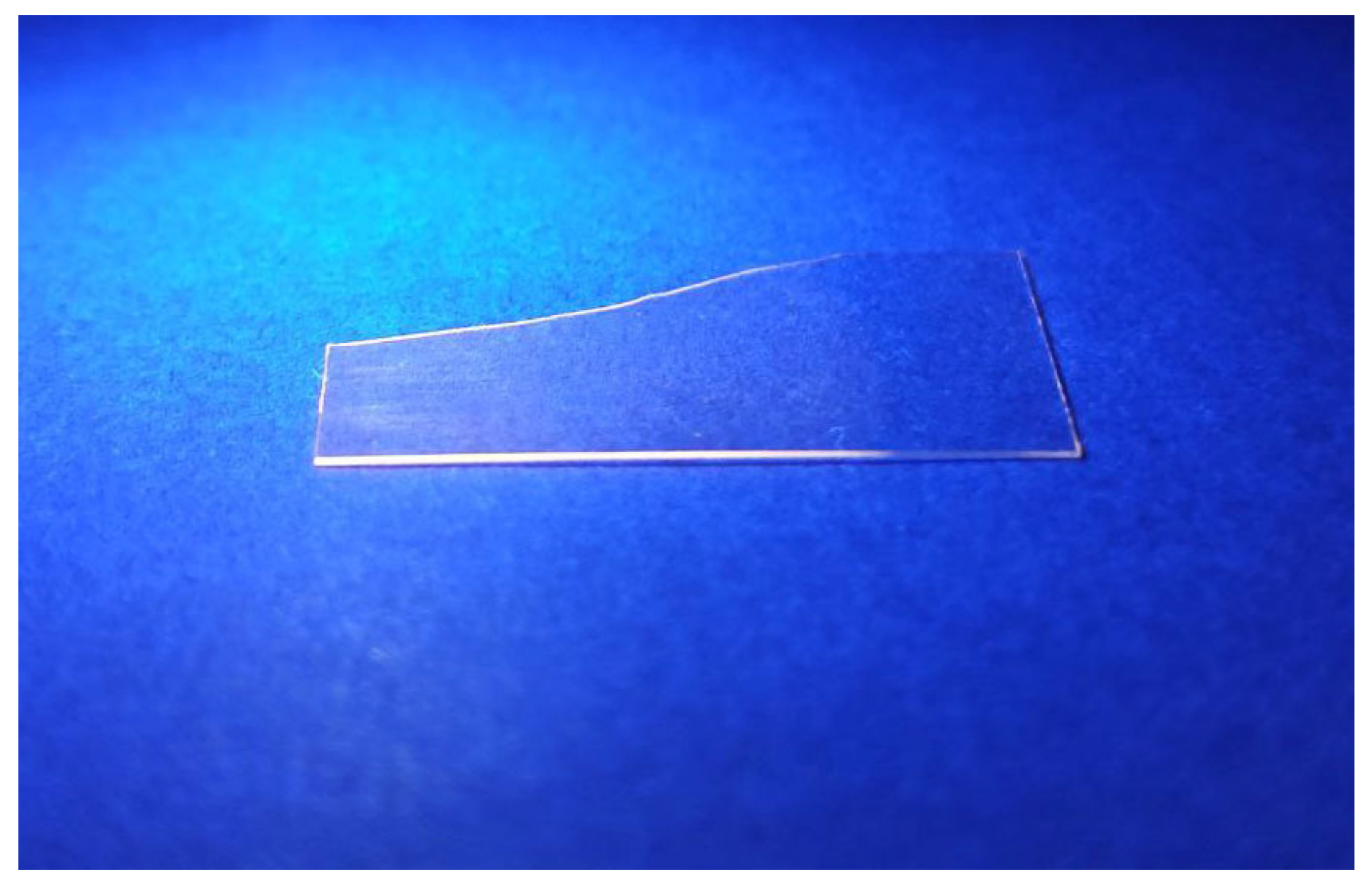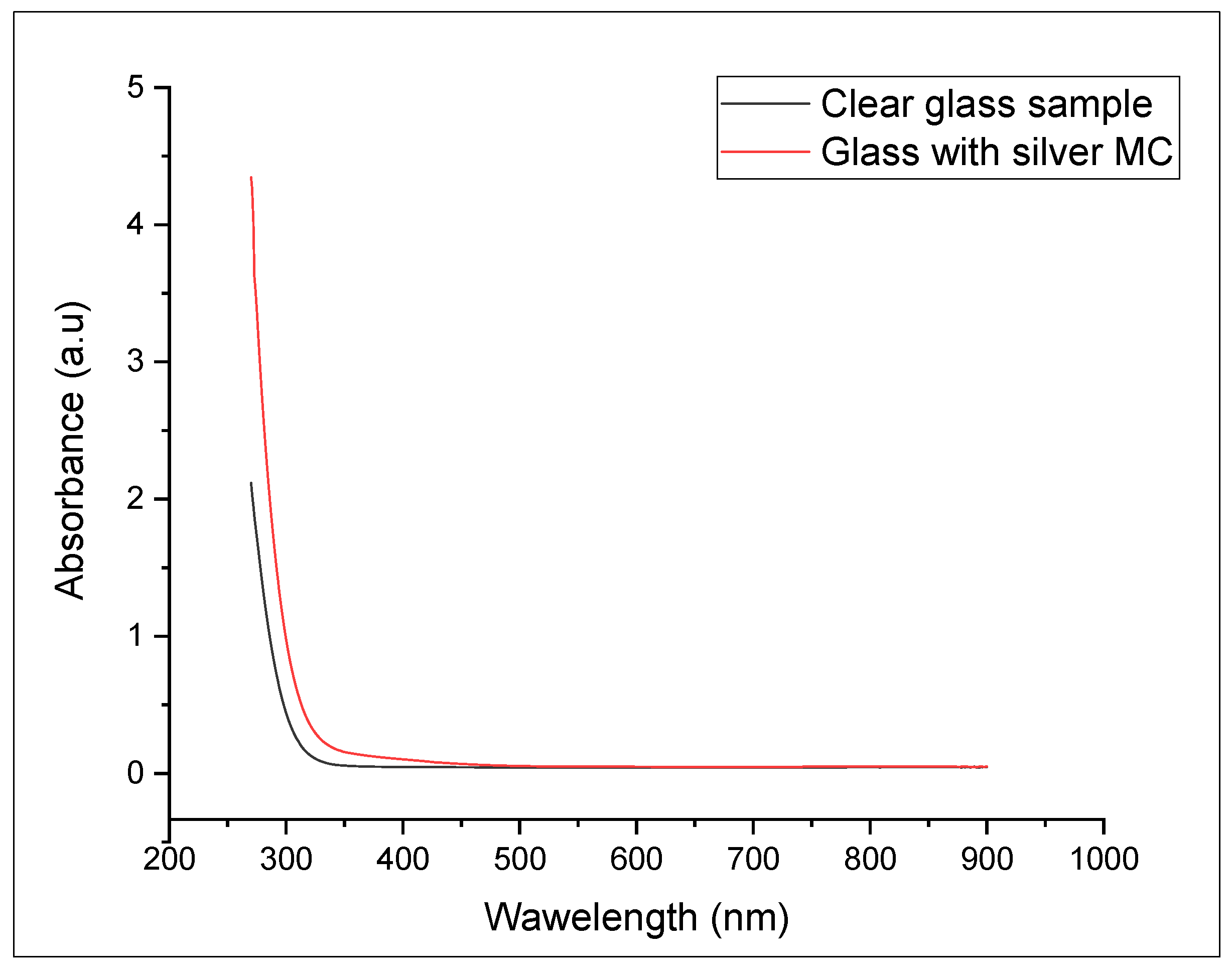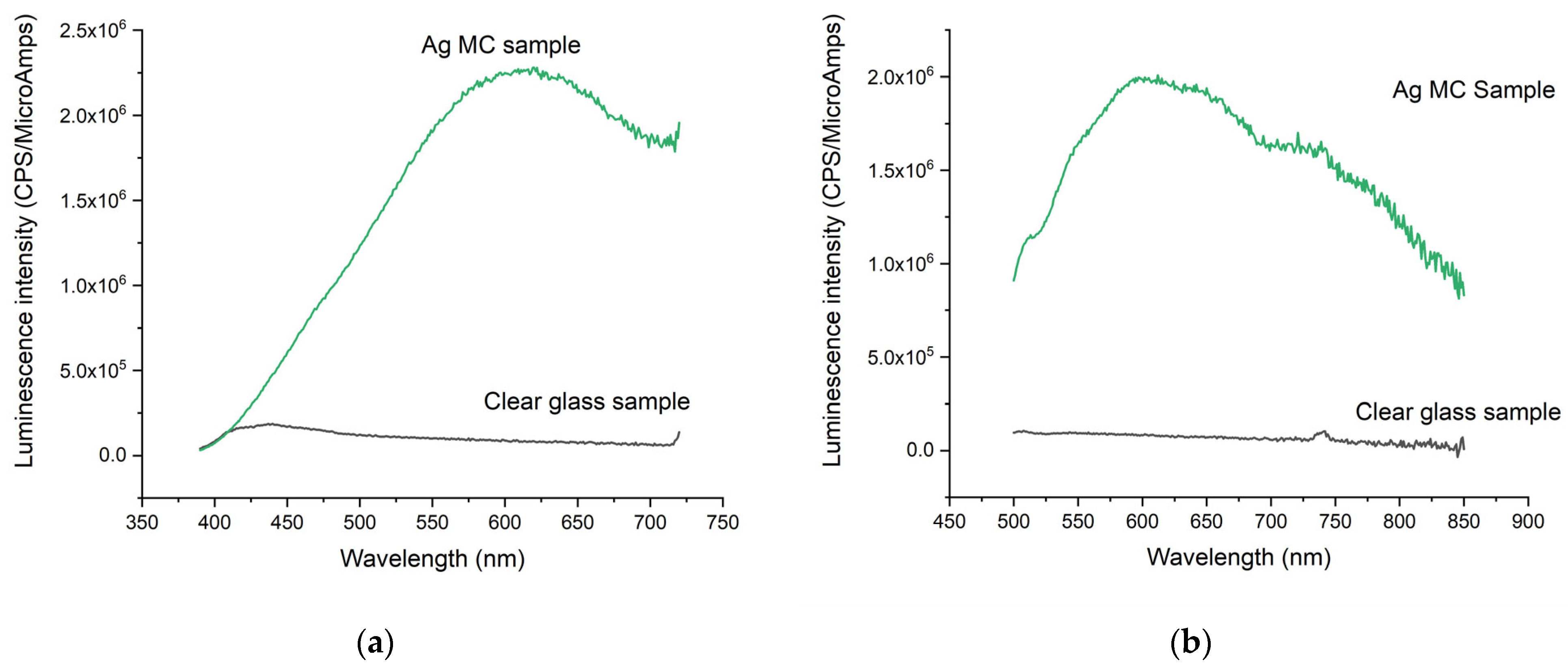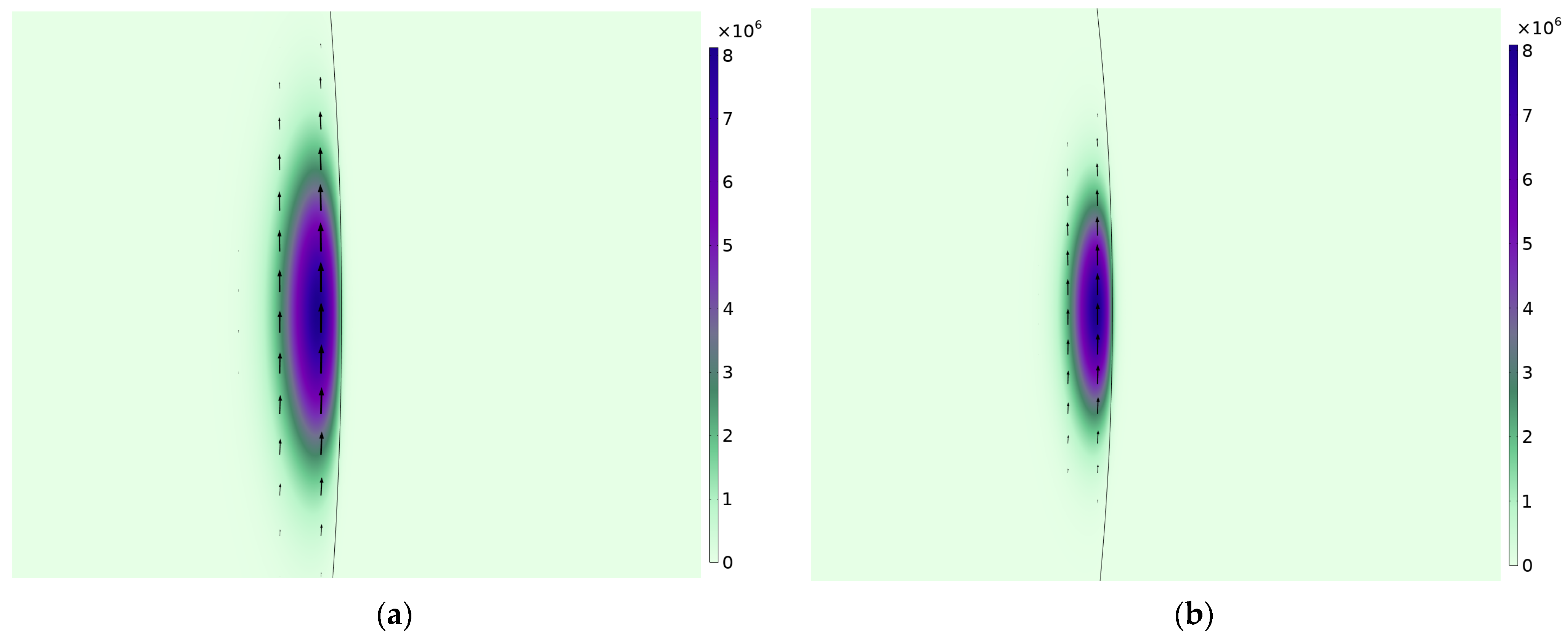1. Introduction
In recent years, Whispering Gallery Mode (WGM) microcavities have garnered significant attention as potential optical sensors for the label-free detection of various biological and chemical molecules and particles. These sensors can identify a range of molecules with refractive indices differing from that of the surrounding environment, eliminating the need for labeling. They rely on the observation of frequency shifts in WGM resonance due to minute perturbations in the mode volume. The efficacy of these sensors has been demonstrated in the detection of a variety of objects, including individual proteins, DNA molecules, and viruses [
1,
2].
In our current research, we explore a novel material for use in these WGM sensors. We focus on silicate glass microspheres containing ions and neutral molecular clusters (MC) of silver. These glasses are exceptional materials that exhibit intense luminescence in the visible spectrum [
3]. They are characterized by high quantum yields and resistance to degradation, making them more appealing than organic dyes. The primary limitation of such sensors lies in the requirement for physical coupling between the WGM resonator and external optics, such as a tapered fiber or bus waveguide, to provide phase-matched evanescent coupling [
4]. An alternative approach is the concept of WGM sensors with optically active resonators [
5], which enables pumping in the UV region via LEDs and remote measurements through free space optics.
The ion exchange (IE) method is currently widely utilized for synthesizing multifunctional glasses. This method is straightforward to execute and enables the attainment of a high concentration of silver ions near the glass surface. Although studies on glasses with Ag+ ions and silver ions obtained through the IO method have been conducted for more than half a century, their potential remains far from being fully explored.
In soda-silicate glass, silver initially exists in its ionic form as Ag+. Structural defects in the glass may contain uncompensated negative charges. These defects can arise from various factors, including defects in the crystal lattice of the glass or the presence of additional ions that can form negatively charged sites. In the presence of electronic defects near glass structural defects, silver ions Ag+ can readily be reduced to neutral silver atoms Ag0. This reduction occurs when the glass is heated, and electrons are released from electronic defects. Neutral silver atoms Ag0 can aggregate into molecular clusters, potentially comprising multiple silver atoms, each with unique optical and electronic properties. The formation of these molecular clusters can be induced by the characteristics of glass structure defects and heating conditions.
2. Materials and Methods
To create the silicate glass microspheres, we employed glass with the composition detailed in
Table 1. The production process involved several steps. Initially, we crafted a thin fiber, and subsequently, we formed the microspheres by melting the fiber’s end using a propane flame. The microspheres were then subjected to the Low-Temperature Ion Exchange (LTIE) process.
The ion exchange process occurred in a molten salt mixture of silver nitrate (AgNO3) and sodium nitrate (NaNO3) at a temperature of 330 °C for a duration of 15 min. To monitor the progress of the process, we also included witness glasses with the same composition. These glasses, with a thickness of 0.17 mm, underwent the ion exchange process alongside the microspheres in a common crucible.
Following the LTIE process, we meticulously cleansed the samples. This cleansing process involved washing with distilled water and then with isopropyl alcohol to eliminate any residual salts remaining on the surface after the process.
Figure 1 display photographs of the samples we obtained. Notably, the smallest sample achievable through the described method had a diameter of 200 microns.
Figure 2 shows one of the witness samples that was not completely immersed in the crucible; when the sample was illuminated with an LED with a wavelength of ≈390 nm, the luminescence of molecular clusters of silver was clearly visible, and the area where the glass passes was not immersed in the molten salts.
Comsol Multiphysics was employed to determine the resonant frequencies and fundamental modes of the resonator. For an effective modeling of the WGM resonator, a two-dimensional axisymmetric approach was adopted. The grid was manually adjusted to facilitate a two-dimensional axisymmetric natural frequency analysis.
The investigation of the properties of silicate glass containing silver molecular clusters, synthesized through the LTIE method, encompassed both absorption measurements and luminescence spectra measurements. Absorbance measurements were conducted on the witness samples using a UV-VIS spectrophotometer (PB 2201). Luminescence spectral acquisition measurements were performed using a Fluorolog®-3 instrument with FluorEssence™ (HORIBA Jobin Yvon SAS, Palaiseau, France). For all luminescence measurements, the integration time was 0.1 s.
3. Results and Discussion
3.1. Investigation of the Properties of Silicate Glass Containing Silver Molecular Clusters
An experiment was conducted to measure the absorption of glass samples that underwent Low-Temperature Ion Exchange (LTIE), as well as transparent glass samples that were not subjected to LTIE treatment. The resulting spectrum is depicted in
Figure 3. Notably, the absorption spectrum of the samples after the LTIE process lacks characteristic absorption peaks. This absence is attributed to the fact that, under the same process parameters used in the treatment, predominantly silver molecular clusters, such as Ag
2...5, are formed [
6].
Figure 4 presents the results of measuring the luminescence intensity. When excited at wavelengths of 370 nm and 390 nm, the luminescence spectra of all synthesized glasses exhibit a broad luminescence band within the visible spectrum. This broadband luminescence spanning from 500 to 900 nm corresponds to the emission emanating from a small quantity of silver microcrystals formed directly during the LTIE process [
7]. To generate molecular clusters (MC), it is imperative to reduce silver ions to their atomic state. This transformation leads to the creation of a certain quantity of silver microcrystals during the LTIE process, consequently giving rise to weak luminescence across the entire visible range.
3.2. Modeling WGM Resonators
The simulated microspheres had a radius of 100 μm. During the LTIE process with silver, glass changes its refractive index from 1.585 on the surface to 1.515. The simulated microsphere had a gradient refractive index from the edge of the microsphere to the center. To explore the potential of this material, simulations of microspheres in air and water were carried out.
Figure 5 shows the distribution of the EM field in the cross-section of the microcavity in air (a) and water (b). The resonant wavelength for the fundamental mode of the microresonator near the luminescence peak was determined. For a microsphere in air, the resonant wavelength for the fundamental TE mode with azimuthal number 1608 was 600.988. For a microsphere in water, the resonant wavelength for the fundamental TE mode with azimuthal number 1608 was 601.294. The difference between the resonant wavelengths was 0.25 nm.
4. Conclusions
We have obtained a new material that is suitable for use in label-free sensors with active WGM resonators. This material is very simple to obtain and cost-effective. The experiment showed that glass samples subjected to Low-Temperature Ion Exchange (LTIE) showed distinct absorption characteristics, particularly the absence of characteristic absorption peaks, which was attributed to the formation of Ag2...5 molecular clusters of silver. Luminescence measurements demonstrated a broad emission band in the visible spectrum, especially in the 500–900 nm range, confirming the formation of silver microcrystals during the LTIE process.
According to the simulation results, the difference between the resonant wavelengths for media with different refractive indexes was 0.26 nm. This allows the material to be used for microsphere sensors without direct physical connection. The results obtained show the potential of soda silicate glass with molecular silver clusters as a material for WGM sensors.
Author Contributions
Conceptualization, E.M. and A.S.; methodology, A.S.; software, A.L.; validation, E.M. and A.L.; formal analysis, A.S.; investigation, A.L. and E.M.; resources, D.R.; data curation, A.S.; writing—original draft preparation, E.M.; writing—review and editing, E.M. and A.L.; visualization, A.L.; supervision, A.L.; project administration, D.R. All authors have read and agreed to the published version of the manuscript.
Funding
This research received no external funding.
Institutional Review Board Statement
Not applicable.
Informed Consent Statement
Not applicable.
Data Availability Statement
Data are contained within the article.
Conflicts of Interest
The authors declare no conflict of interest.
References
- Foreman, M.R.; Swaim, J.D.; Vollmer, F. Whispering gallery mode sensors. Adv. Opt. Photon. 2015, 7, 168–240. [Google Scholar] [CrossRef] [PubMed]
- Vollmer, F.; Arnold, S. Whispering-gallery-mode biosensing: Label-free detection down to single molecules. Nat. Methods 2008, 5, 591–596. [Google Scholar] [CrossRef] [PubMed]
- Demichev, I.A.; Ignat’ev, A.I.; Nikonorov, N.V.; Sgibnev, E.M.; Sidorov, A.I.; Khrushcheva, T.A.; Shakhverdov, T.A. Specific features of the luminescence of silicate glasses with silver introduced by ion exchange. Opt. Spectrosc. 2014, 116, 587–592. [Google Scholar] [CrossRef]
- Wienhold, T.; Kraemmer, S.; Wondimu, S.F.; Siegle, T.; Bog, U.; Weinzierl, U.; Schmidt, S.; Becker, H.; Kalt, H.; Mappes, T.; et al. All-polymer photonic sensing platform based on whispering-gallery mode microgoblet lasers. Lab Chip 2015, 15, 3800–3806. [Google Scholar] [CrossRef] [PubMed]
- Hanumegowda, N.M.; White, I.M.; Oveys, H.; Fan, X. Label-free protease sensors based on optical microsphere resonators. Sens. Lett. 2005, 3, 315–319. [Google Scholar] [CrossRef]
- Sheng, J.; Li, J.; Yu, J. The development of silver nanoclusters in ion-exchanged soda-lime silicate glasses. Int. J. Hydrog. Energy 2007, 32, 2598–2601. [Google Scholar] [CrossRef]
- Simo, A.; Polte, J.; Pfander, N.; Vainio, U.; Emmerling, F.; Rademann, K. Formation Mechanism of Silver Nanoparticles Stabilized in Glassy Matrices. J. Am. Chem. Soc. 2012, 134, 18824–18833. [Google Scholar] [CrossRef] [PubMed]
| Disclaimer/Publisher’s Note: The statements, opinions and data contained in all publications are solely those of the individual author(s) and contributor(s) and not of MDPI and/or the editor(s). MDPI and/or the editor(s) disclaim responsibility for any injury to people or property resulting from any ideas, methods, instructions or products referred to in the content. |
© 2023 by the authors. Licensee MDPI, Basel, Switzerland. This article is an open access article distributed under the terms and conditions of the Creative Commons Attribution (CC BY) license (https://creativecommons.org/licenses/by/4.0/).










